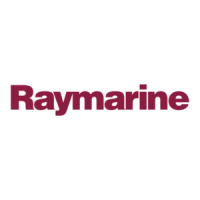Chapter 2: Installation 2-11
Cable Runs
2.4 Cable Runs
Consider the following before installing the system cables:
• You need to attach the power cable and the transducer cable. Additional
cables will be required if you are installing an integrated system.
• All cables should be adequately secured, protected from physical damage
and protected from exposure to heat. Avoid running cables through bilges
or doorways, or close to moving or hot objects.
• Acute bends must be avoided
• Where a cable passes through an exposed bulkhead or deckhead, a water-
tight feed-through should be used.
• Secure cables in place using tie-wraps or lacing twine. Coil any extra cable
and tie it out of the way.
You need to run the following cables:
• Power/NMEA Input cable, supplied with the display unit. This has a con-
nector plug at one end for connecting the display unit, and 7 wires at the
other end for connecting the power supply and optional NMEA inputs (see
Integrated Systems on page 2-18).
• Transducer cable, supplied with the transducer. This 30 ft (10 m) cable
has a connector plug (with an outer nut that you must attach) at one end for
the display unit or extension cable.
• SeaTalk cable, optional, with SeaTalk connector(s) at one or both ends.
• HSB cable, optional.
• NMEA Output cable, optional, with an NMEA OUT connector at one
end only.
Power Cable
The
hsb
2
Plus Series Fishfinder is intended for use on ships’ DC power
systems rated from 10.7 V to 32 V.
A 5 ft (1.5 m) power cable is supplied for connecting the ship’s DC power to
the display unit. The power cable may be extended by up to 60 ft (20 m) using
a wire gauge of AWG 12 (3.5 mm
2
) or greater.
Transducer Cable
A 30 ft (10m) cable is supplied with the transducer. The transducer cable may
be extended up to a maximum of 60 ft (20 m) using optional extension cables.
For details, see document number 81196, Transducers for Fishfinders
Owner’s Handbook.

